Home » Jazz Articles » Building a Jazz Library » Fusion
Fusion
Since the early 1970s, fusion music has served as an appreciable back door for people seeking an entry into the complexities of jazz. The term "fusion" refers to the blending together of jazz, rock, world music, classical, or other influences into a concrete whole. Most often it's applied to a form of music also known as "jazz-rock," which first gained wide popularity with Miles Davis' electric-jazz experiments in the late 60s. Today there is an earnest resurgence in fusion across America and the world, with a vast number of technically brilliant musicians creating exciting sounds, and classic recordings being reissued in droves. Before dealing with the current scene, however, it's best to begin building a fusion library by heading back to its roots.
Prior to Davis' innovations, a small scattering of jazzmen attempted to fuse jazz and rock. British guitarist Alexis Korner cut his first album of electric jazz-blues as early as 1962, and other British electric-bluesmen (Graham Bond, John Mayall) flirted with jazz inflections throughout the 60s. In about 1966 the Free Spirits (guitarists Chip Baker and Larry Coryell, saxophonist Jim Pepper, drummer Bob Moses, bassist Chris Hills) began toying with a union of jazz and the pop sounds that had set American youth on fire: Bob Dylan, the Beatles, the Stones. Unfortunately, the Free Spirits' sole album, Out of Sight and Sound (1966, ABC-Paramount), has been unavailable for decades despite being the true herald of jazz-rock fusion's arrival. The concept was still shaky and Coryell's vocals did little to help matters, but for its landmark status alone it is a valuable record.
Coryell moved on to work with trumpeter Randy Brecker, then with vibraphonist Gary Burton's quartet. In '66 Burton had semi-successfully fused jazz and country on the album Tennessee Firebird (RCA), produced by Chet Atkins. Moving towards rock seemed the next logical step. Albums like Duster (RCA, 1967) followed, utilizing rock rhythms and Coryell's acidic tone to good advantage. Decked out in beaded buckskins, Burton subsequently became a favorite feature of American rock festivals.
 Gary Burton
Gary BurtonDuster (1967, RCA; reissued 1997, Koch)
Burton's first successful entry into jazz-rock fusion, still more jazz than rock but pointing the way ahead. Compositions by bassist Steve Swallow, Carla Bley and Mike Gibbs are savvily interpreted by Burton, Swallow, Larry Coryell and drummer Roy Haynes. Coryell's sharp tone, deeply inflected by the blues, offers the main rock flavoring on tunes like "Ballet," "Liturgy," and Swallow's hippie-esque "General Mojo's Well-Laid Plan." The album received an astonishing 5-star review from Down Beat upon its initial release.
Following his service with Burton, Coryell joined with saxophonist Steve "The Count" Marcus to form Count's Rock Band. The group was rounded out by Chris Hills and Bob Moses from the Free Spirits, New Zealand-born keyboardist Mike Nock, and percussionist Chris Swanson. Their assimilation of rock elements was more overt than in Burton's quartet. Pop song covers and Nock's kitschy harpsichord assured a young following for Count's Rock Band for a time. The group's self-titled debut album was released in '69 on the Vortex label (an Atlantic subsidiary), concurrently with Marcus' own effort, The Lord's Prayer.
 Count's Rock Band/Steve Marcus
Count's Rock Band/Steve MarcusCount's Rock Band/The Lord's Prayer (reissued 1999, Collectables Jazz Classics)
This Collectables two-fer combines a pair of Marcus-centered albums from '69 that cross over between jazz and rock with varying degrees of success. There's "hippie" written all over much of this, but in a fairly pleasing way. "Theresa's Blues," "Scarborough Fair," Chris Hills' "Ooh Baby," Bob Moses' lovely ballad "Amy," Miroslav Vitous' "Hope," and the lushly orchestrated "T. with Strings" are the high points and well worth the price. The Count's material suffers a bit from questionable accordion sections and puny solo interludes. But despite the featherweight melody, the Stones' "Back Street Girl" is priceless for its headlong leap into free-jazz fury. The Lord's Prayer material is even sketchier: the eight-minute "Hey Jude" plods along like a zombie, drummer Larry Clark thinks far too much of himself, "The Lord's Prayer" doesn't make for good free jazz, and the godawful kid-with-her-recorder rendition of "America" is a national insult. But the myriad faults aside, this two-fer still has some excellent, innovative music to recommend it. For historical purposes, pick it up and then program your player selectively.
From his development of cool jazz in the late 40s on, Miles Davis was one of the most consistently innovative musicians in jazz. His relaxed, Harmon-muted style of bop in the mid-50s gave way to modal scale experiments, ambiguous forms sans chords, tense ostinato pieces, and finally the blending of acoustic and electronic instruments. It's said that Miles' confluence of jazz and rock stemmed as much from Columbia Records' threats to drop him if he didn't produce more hits as from his personal pursuit of innovation. Whatever the cause, Davis brought in a succession of keyboard players who concentrated on electric piano and organ: Joe Zawinul, Herbie Hancock, Chick Corea, Keith Jarrett. These fresh sounds added vitality and rich textures to Davis' band, and the music created around the new instruments was like little heard before. His first full-body leap into jazz-rock fusion came with In A Silent Way (1969, Columbia) in close collaboration with Zawinul, who had previously dealt out masterful soul-jazz with Cannonball Adderley's groups. The album was a clarion call to forward-minded players and fans, a firm indication that the new music could indeed be successfully combined with the old.
 Miles Davis
Miles DavisThe Complete In A Silent Way Sessions (tracks originally issued 1969; reissued 2001, Columbia/Legacy)
On the ground-breaking In A Silent Way, the acoustic instruments of Davis, Wayne Shorter, Dave Holland and Tony Williams were combined with John McLaughlin's electric guitar, Joe Zawinul's organ, and the twin electric pianos of Chick Corea and Herbie Hancock. Each side of the original LP held a medley of two themes. Miles' 18-minute-plus "Shhh/Peaceful," dramatically tense, followed by Zawinul's lovely title tune, buoyed by a bass drone and sporadic keyboard pulses. Partway through its proceedings, the more ominous minor theme of Miles' "It's About That Time" emerges, a subtle but telling change of mood. Both sides featured virtuosic playing by all the musicians, particularly the then-unfamiliar McLaughlin. The album has been reissued under the Columbia/Legacy imprint. The three discs in this set contain sessions from a six-month period (September '68 to February '69) when Miles was experimenting heavily with electronic instrumentation in a jazz context. Several of these tracks were originally issued on later albums: Filles de Kilimanjaro ('68); Water Babies ('76); Circle in the Round ('79); and Directions ('81). Other tracks are heard here for the first time. In finally hearing this continuum of music in the order in which the pieces were recorded, the progression from the forbidding modality of the Shorter/Williams acoustic band to the eventual funk-rock mayhem of Bitches Brew is made especially clear. Jack DeJohnette and Joe Chambers each hold the drum chair on certain tracks. This set sheds new light on the directions that Miles was considering in the period, smooths out some rough jumps in his discography, and offers a glimpse at the evolution of these timeless sessions. Essential and simply astonishing.
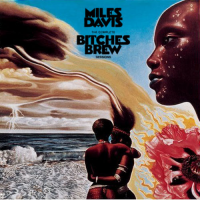 Miles Davis
Miles DavisThe Complete Bitches Brew Sessions (tracks originally issued 1969, Columbia; reissued 1998, Columbia/Legacy)
Davis followed In A Silent Way with a double-disc release that both broke new ground in studio technology and set his course for the next few years. Few albums can claim the controversy of Bitches Brew , recorded in August 1969 and engineered in an unusual cut-and-paste fashion by Teo Macero. Davis and his cadre recorded a huge volume of music over those three days, which Macero then assembled into a shocking collage of funky bass ostinatos, crushingly powerful solo snippets, echo effects, and some of the loudest ensemble work ever recorded up to that time. Wayne Shorter's soprano and John McLaughlin's fiery electric guitar slice furiously through the dance-beat jungle conjured by Chick Corea, Jack DeJohnette, acoustic bassist Dave Holland, bass guitarist Harvey Brooks, and the rest of the entourage. The "Complete" reissue includes alternates and outtakes culled from the mountain of tape Macero initially wove into a frightening masterpiece, some of which were later issued on Big Fun and Circle in the Round. Even if you end up hating it, Bitches Brew is one of those albums that one must hear in order to understand what followed it. Subsequent efforts like On The Corner and Get Up With It (all remastered and reissued by Columbia/Legacy in the past few years) drew from the Bitches Brew formula, until Davis' groove finally seemed to get stuck in a morass of sameness.
The late 60s saw a new vogue in rock bands sporting horn sections, with a few successes and many clones. Blood, Sweat and Tears and Chicago ruled the roost, with Tower of Power stirring in the funk later on. The Ides of March and vibraphonist Mike Mainieri's White Elephant were less prosperous, while Chicago's The Flock have been all but forgotten. More's the pity, since their self-titled album is one of the best of the bunch. Led by guitarist Fred Glickstein, The Flock's ace in the hole was violinist Jerry Goodman, a long-haired wildman whose ferocious improvisations could levitate the bandstand.
.jpg) The Flock
The FlockThe Flock (1969, Columbia; reissued 1996, Sony Music Special Products)
A phenomenal release by an underappreciated force in jazz-rock fusion. The opening guitar/violin duo tips us off that this isn't your average album. Guitarist Fred Glickstein's singing and songwriting is reminiscent of the Jefferson Airplane's Marty Balin. Jerry Goodman's violin usually steals the show; his psychotic intro to the ultra-groovy cover of The Kinks' "Tired of Waiting" is a kick in the head. The funky horn line and "yeah, yeah" backing vocals stack up the good, clean fun.
Meanwhile, back in the UK, the members of the so-called "Canterbury school" were fashioning their own fusion hybrid. In 1968 drummer/singer Robert Wyatt, guitarist Kevin Ayres and organist Michael Ratledge formed the Soft Machine, which originally played an extension of the electric blues of Graham Bond and the Cream. Bassist Hugh Hopper joined in time for the band's second album, followed by saxophonist Elton Dean. After a few years the Soft Machine morphed from a blues-rock band into a jazz ensemble with rock undertones. They were one of Europe's most influential crossover bands during their decade of life, inspiring the eventual birth of Gong, Matching Mole, and other units. On the more soulful side of the tracks was keyboardist/singer Brian Auger, whose bands Trinity and Oblivion Express got down and funky for much of the 60s and 70s.
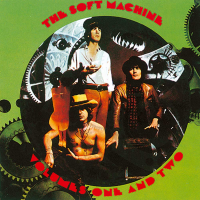 Soft Machine
Soft MachineVolumes I and II (1968-69, MCA; reissued on one CD 1995, Big Beat)
The first two Soft Machine albums, combined on one gloriously strange CD. Robert Wyatt's effeminate falsetto vocals are a stark contrast to Michael Ratledge's abrasive organ tone and Kevin Ayres' shimmering guitar. The music is schizophrenic at times, scooting quickly from tender ballad to rhythmic free-for-all. Psychedelic anthems share space with gentle interludes, white-boy R&B, and "The Concise British Alphabet" (forwards and backwards, yet). Horns are added for the avant-leaning "Out of Tunes" and Mingus-flavored "Orange Skin Food," increasing the jazz profile. Essential if a tad bizarre.
 Brian Auger's Oblivion Express
Brian Auger's Oblivion ExpressThe Best of Brian Auger's Oblivion Express (1996, Polygram)
Two discs of prime Auger, highlighting two dozen tracks including covers of Eddie Harris' "Freedom Jazz Dance," Wes Montgomery's "Bumpin' on Sunset," and Marvin Gaye's "Inner City Blues (Make Me Wanna Holler)," and originals like "Dragon Song" and "Second Wind." Auger and friends at their soulful best.
Stateside, John McLaughlin joined ex-Davis drummer Tony Williams and organist Larry Young to form the trio Lifetime. Williams' aggressiveness complemented McLaughlin's acid attack and Young's angular technique in a mind-boggling union of technical expertise. Lifetime debuted on record in 1969 with Emergency! (Polydor), a brilliant showcase for the three men's exceptional talents. McLaughlin in particular barged brashly through the doors that Coryell had kicked open a few years prior, his scathing tone powerful enough to chip paint off the walls. Williams continued his climb into fusion prominence with his next band, Spectrum, while Young moved into free jazz until his untimely death in 1978. And, as he later revealed, McLaughlin had his own tricks up his sleeve.
 Tony Williams Lifetime
Tony Williams LifetimeEmergency! (1969, Polydor; reissued 1997, Polygram)
The incendiary debut of a sensational fusion trio. From the first tense alarum of the opening track, Williams, John McLaughlin and Larry Young stage an unmerciful assault on the status quo of jazz. Young's anxious organ tone is especially disquieting all through the session. The double-tracked blues guitars of "Via the Spectrum Road" are marvelous. The sole downer here is Williams' unconvincing vocals, but they do little to tame the intensity of this unparalleled set.
In the summer of '71 McLaughlin formed his own multicultural group with ex-Flock violinist Jerry Goodman, Czech pianist Jan Hammer, Irish bassist Rick Laird and Panamanian drummer Billy Cobham. The Mahavishnu Orchestra was inspired by McLaughlin's interest in Indian musics and cultures, particularly the teachings of Sri Chinmoy, and the group's almost impenetrably complex music marked a new horizon in fusion's development. Loud volume, lightning speed and exotic time signatures and scales were among the hallmarks of Mahavishnu. For a few years McLaughlin's ensemble represented the pinnacle of fusion, but by 1974 the concept had grown thin and a mid-80s reunion simply fizzled.
 Mahavishnu Orchestra
Mahavishnu OrchestraThe Inner Mounting Flame (1971, Columbia; reissued 1998, Columbia/Legacy)
The debut of one of fusion's most technically phenomenal bands. McLaughlin and company navigate harrowing original compositions with breakneck speed and unmatched articulation, resulting in music of fresh excitement and constant surprises. The leader's electric guitar is unbearably intense at times, while his acoustic work is gentle as a lamb. This is a band in the best sense of the word, each member contributing complementary parts to the greater whole.
 Mahavishnu Orchestra
Mahavishnu OrchestraBirds of Fire (1972, Columbia; reissued 2001, Columbia/Legacy)
Mahavishnu's second effort went gold and rode the Billboard charts for 11 weeks. Some of McLaughlin's exotic spirituality and Hammer's synthesizers seem a bit cloying in hindsight (in what other decade could the tiny noise clusters of "Sapphire Bullets of Pure Love" have been put to wax?) but the unbridled virtuosity and creativity here remain undiminished. The stunning sonic embroidery can still knock listeners flat on their backs, Cobham's insane pace gives veteran drummers pause, and McLaughlin's controlled burblings carry even more propulsive weight in this digital repackaging.
 Billy Cobham
Billy CobhamRudiments: The Billy Cobham Anthology (2001, Rhino)
In 1973 Billy Cobham broke from the Mahavishnu ranks and became a bandleader in his own right, crafting some of the most exciting (and occasionally generic) fusion of the 70s and 80s. He started the ball rolling that year with Spectrum , an Atlantic issue which included Mahavishnu keyboardist Jan Hammer, session bassist Lee Sklar, and young guitar wizard Tommy Bolin. Later gatherings under the titanic drummer's leadership featured keyboardist George Duke, bassists John Williams, Alphonso Johnson and Alex Blake, the Brecker Brothers (trumpeter Randy and reedman Michael), guitarists John Scofield and John Abercrombie, and many others. Rudiments collects some of Cobham's best tracks recorded for the Atlantic label, focusing largely upon his amazing drum skills and respectable compositions.
Despite the work of Jerry Goodman and other pioneers, it was Jean-Luc Ponty who almost single-handedly carved a niche for the violin within fusion. From his earliest efforts with Frank Zappa (the wonderful King Kong ) through his mega-hit 1970s albums like Imaginary Voyage , Ponty was the voice of fusion violin for a couple of decades. In the 90s his star faded a bit as he returned to France and took part in specialty projects like The Rite of Strings, with guitarist Al DiMeola and bassist Stanley Clarke, but he quickly returned to prominence in the new century.
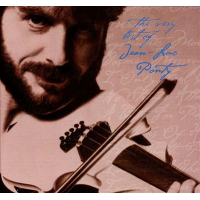 Jean-Luc Ponty
Jean-Luc PontyThe Very Best of Jean-Luc Ponty (2000, Rhino)
A "best-of" that's truly worthy of its title, this release collects sixteen of Ponty's best tracks from his 1970s heyday. He performs on both acoustic and electric violins on favorites such as "Infinite Pursuit," "Bowing-Bowing" (with guest Patrice Rushen on keys), "Cosmic Messenger," "New Country," and "Enigmatic Ocean, Part 3."
Keyboardist Chick Corea also built a platinum career after his tenure with Miles Davis. After some excellent acoustic albums and a brief dabbling in free jazz with the quartet Circle, Corea went in a completely new direction in 1971 with his band Return To Forever. Originally a mostly acoustic ensemble featuring Brazilian singer Flora Purim and her husband, percussionist Airto Moreira, RTF blossomed into a powerful fusion group with guitarist Al DiMeola, electric bassist Stanley Clarke and drummer Lenny White among its heavies.
 Return To Forever
Return To ForeverRomantic Warrior (1976, Columbia)
Given the absence of a really good overview of RTF's output (both the Columbia Best Of and Sony's This Is Jazz, Vol. 12 , devoted to the band, are insufficient), this 1976 release is probably the best starting place to appreciate the band in their prime. (Its Grammy-winning predecessor, No Mystery , is ironically unavailable now.) Corea, DiMeola, Clarke and White were at the peak of their group intuitiveness here, and the themes were among the band's most entertaining. The tunes by DiMeola were especially exciting, demonstrating the rock-tinged chops that he later let slide in favor of more introspective forms. RTF subsequently became a "horn band" with Joe Farrell and four other wind-blowers, and the music lost a great deal of its edge. Romantic Warrior was sort of the last hurrah of a truly great concept. Clarke went on to become one of the most inspirational bassists in contemporary music, though a string of poorly executed albums bogged him down in sorry funk and soul gunk.
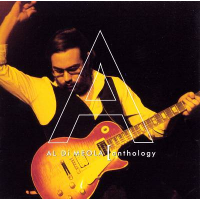 Al DiMeola
Al DiMeolaAnthology (2001, Columbia/Legacy)
After departing Return To Forever, DiMeola became yet another of Columbia's shining fusion stars with a series of impressive albums between 1975 and 1983. This collection showcases the best of those discs, centered upon his mind-boggling chops and equal appreciation of Latin and classical forms. His sidemen here include guitarist Anthony Jackson, drummers Steve Gadd, Alphonse Mouzon and Lenny White, bassist Jaco Pastorius, keyboardist Jan Hammer, and even Genesis drummer Phil Collins on one track. Unlike Corea, Clarke, and many of his other contemporaries, DiMeola's recordings from this period tend to sound fresh and exciting even a quarter-century along. "Land of the Midnight Sun," "Race With Devil on Spanish Highway" Corea's "Senor Mouse," "Bianca's Midnight Lullaby," and "Egyptian Danza" are among the high points of this two-disc compendium.
Like RTF, Weather Report began its life as an almost acoustic ensemble. Keyboardist Joe Zawinul and saxophonist Wayne Shorter, two more Davis alumni, formed the band's core for its whole life. The original incarnation of Weather Report, a quintet with bassist Miroslav Vitous, drummer Alphonse Mouzon and percussionist Airto Moreira, released their self-titled debut on Columbia in 1971. A large number of personnel changes then ensued, particularly in the drum and percussion chairs (only Spinal Tap was harder on drummers!) In 1973 Vitous was replaced by the more funk-minded Alphonso Johnson, an highly impressive bassist who was unfortunately overshadowed by his own replacement: Jaco Pastorius. The double-jointed, maniacally animated Jaco soon became the be-all and end-all of electric bass, his stupendous technique and imagination inspiring the next full generation of bassists and almost obscuring his bandmates' contributions to Weather Report's awesome presence. Heavy Weather , from 1977, gave the band its biggest hit ("Birdland") and a #1 spot on the Billboard jazz chart. After Jaco's departure, Victor Bailey held the bass chair for a few more years until Weather Report folded in 1985, Shorter deciding to move on to new adventures. Zawinul briefly attempted to keep the ship afloat as Weather Update, with guitarist Steve Khan up front, but to little avail.
 Weather Report
Weather ReportThe Best of Weather Report (2002, Columbia/Legacy)
An excellent collection of mid-period WR tracks, skipping the earliest days with Miroslav Vitous and a few later misses like the band's swansong, This Is This. Produced by Bob Belden, the anthology includes major hits like "Birdland" and "A Remark You Made" along with less-remembered gems like "The Elders" and the Zawinul-Shorter duet "Blackthorn Rose." About as good as a single-disc collection could be; thankfully, almost all of WR's albums have been reissued on CD so one can fill in the gaps. The double-disc Live and Unreleased (2002, Columbia/Legacy) presents many superior concert performances with few disappointments evident.
 Jaco Pastorius
Jaco PastoriusJaco Pastorius (1976, Columbia)
John Francis Pastorius, the self-proclaimed "World's Greatest Bass Player," took the jazz market by storm with his 1976 debut album. Filled to the brim with his signature bravado (how many other people would attempt a solo bass version of Charlie Parker's "Donna Lee"?) Jaco set the standard for bassists worldwide with his use of true and false harmonics ("Portrait of Tracy," "Continuum"), fleet fingerstyle, and wholly original conceptions. Guests include Herbie Hancock and soul singers Sam and Dave.
In the 1980s fusion faced a quick descent from marketplace popularity, as audiences started seeking more personally relative musical and emotional content without all the showy chops that typified what fusion had come to represent. Guitarist Allan Holdsworth was one of the few artists to continue expanding the fusion umbrella without descending into either rock or smooth jazz. The rise of grunge and thrash-metal on the rock side, and glossy-slick contemporary jazz on the other end, meant more nails in the coffins of fusion and its homely cousin, hair-band heavy metal.
 Allan Holdsworth
Allan HoldsworthMetal Fatigue (1985, Enigma)
In the period before Holdsworth fell in love with the Synthaxe and completely changed the face of fusion once again, he was one of the most gifted electric guitarists in the business. His fleet, legato phrasing and pinpoint-accurate use of the tremolo bar were but two signatures of his unique and influential style. This head-spinning album features vocalist Paul Williams, bassist Jimmy Johnson, ex-Zappa drummer Chad Wackerman, and some of Holdsworth's most sizzling guitar work. The title track and "Devil Take The Hindmost" are highlights.
In the mid-1990s, however, a gradual resurgence of interest began creeping back into the industry. Some musicians who had previously let technical skill take the place of musical quality realized their error and began to temper their performances with moderation and more appreciable tunes. Meanwhile, some listeners who had grown tired of what 1990s radio had to offer —increasingly bare-bones music made by people with little or no formal training but plenty of personality flaws —started craving the sort of visceral excitement they had gotten from fusion in times past. With the establishment of Tone Center, a label associated with the Shrapnel rock/metal umbrella, fusion reclaimed a firm hold on the marketplace. Drummer Steve Smith, formerly of Journey and presently of fusion powerhouse Vital Information, plays a key role in Tone Center's A&R and production. Other imprints like Intuition and Favored Nations (founded by shred-metal star Steve Vai) began turning out excellent fusion-oriented albums by Vital Information, bassist Stu Hamm, guitarists Steve Lukather and Larry Carlton, and other artists. The past few years have seen a consistent number of outstanding fusion releases hit the market running.
 Tribal Tech
Tribal TechRocket Science (2000, Tone Center)
Tribal Tech is one of the most prominent ensembles to come out of the new wave of fusion. Guitarist Scott Henderson, bassist Gary Willis, keyboardist Scott Kinsey, and drummer Kirk Covington skillfully navigate the factors that made fusion great: complex but gripping tunes, the highest level of musicianship and technical prowess, and a good dose of fun. Rocket Science is one of their best offerings yet, giving a good-spirited nod to the cheesy sci-fi soundtracks of yore while ever pushing their music towards new frontiers. Danceable, full of laughs, and awe-inspiring by turns.
 Vital Tech Tones
Vital Tech TonesVTT2 (2001, Tone Center)
Another successful team: Tribal Tech guitarist Scott Henderson, drummer Steve Smith, and bassist Victor Wooten of bluegrass-jazz mavens Bela Fleck and the Flecktones. This trio really hit their stride on their sophomore release, blending effortlessly with one another as they pushed their instruments and creativity to the limits. Henderson is simply in a class by himself, a walking textbook of guitar technique and classy note selectivity. .
 Gambale/Hamm/Smith
Gambale/Hamm/SmithThe Light Beyond (2001, Tone Center)
Not to sound like a cheerleader for Tone Center or Steve Smith, but this listing should give you some idea of the high quality of modern fusion under their guidance. This time Smith is teamed with Aussie guitarist Frank Gambale and former Joe Satriani bassist Stuart Hamm on a session marked by startling empathy and exquisite songcraft. Smith's drum layers and Hamm's slaps and pops are sweet complements to Gambale's blissful melodicism.
 Vital Information
Vital InformationLive Around The World: Where We Come From Tour 1998-1999 (2001, Intuition)
A two-disc set of hot highlights from VI's successful world tour. Smith, Gambale, keyboardist Tom Coster, and new bassist Baron Browne play an interesting variety of material including John Coltrane's "Mr. P.C.," Led Zeppelin's "Moby Dick" (which kicks off with a finger-busting solo by Browne), Ornette Coleman's "Happy House," and Carlos Santana's "Europa" (with co-writer Coster on accordion). Always enjoyable, rarely predictable.
In the long interim after Count's Rock Band and the Free Spirits, Larry Coryell played freely with the Jazz Composers Orchestra, got funky with Herbie Mann, and sailed back into fusion with his own Eleventh House. Later on, after kicking his alcohol habit, Coryell established a reputation as a reliable mainstream jazz guitarist of considerable talent. Saxman Steve Marcus, his erstwhile cohort, spent over a decade in Buddy Rich's band with various other projects on the side. In 2001 Tone Center managed to reunite the two old buddies under the appropriate moniker Count's Jam Band, giving them a chance to revisit older material and craft bright new creations as well.
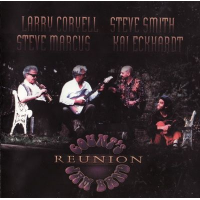 Count's Jam Band
Count's Jam BandReunion (2001, Tone Center)
The long-awaited reunion of Steve Marcus and Larry Coryell, now in the company of Steve Smith and bassist Kai Eckhardt. Excellent alterations of older favorites like "Foreplay," "Scotland," and "Tomorrow Never Knows," a pensive "Ballad for Soprano and Guitar," and more. Jam-band veteran Jeff Chimenti sits in on piano for a couple of tracks. Marcus has been sorely underappreciated as a soprano saxophonist, and Coryell proves that he has lost little of his grand old fire. An essential document of contemporary fusion.
 Jean-Luc Ponty
Jean-Luc PontyLife Enigma (2001, JLP Productions)
After a rather quiet period of reflection and experimentation, Ponty re-emerged in 2001 with his own label and this marvelous offering. Life Enigma reconfigures the pop consciousness of his past into a sound more appropriate for the new century, with Ponty's violin sometimes run through a Synclavier for beautiful washes of color and texture. On the tracks that Ponty didn't assemble entirely on his own, the band includes bassist Guy Nsangué Akwa, percussionist Moustapha Cissé, drummer Thierry Arpino, and pianist William Lecomte.
< Previous
The Jazz Instrument
Next >
Decisions
Comments
About Weather Report
Instrument: Band / ensemble / orchestra
Related Articles | Concerts | Albums | Photos | Similar ToTags
For the Love of Jazz
 All About Jazz has been a pillar of jazz since 1995, championing it as an art form and, more importantly, supporting the musicians who create it. Our enduring commitment has made "AAJ" one of the most culturally important websites of its kind, read by hundreds of thousands of fans, musicians and industry figures every month.
All About Jazz has been a pillar of jazz since 1995, championing it as an art form and, more importantly, supporting the musicians who create it. Our enduring commitment has made "AAJ" one of the most culturally important websites of its kind, read by hundreds of thousands of fans, musicians and industry figures every month.























